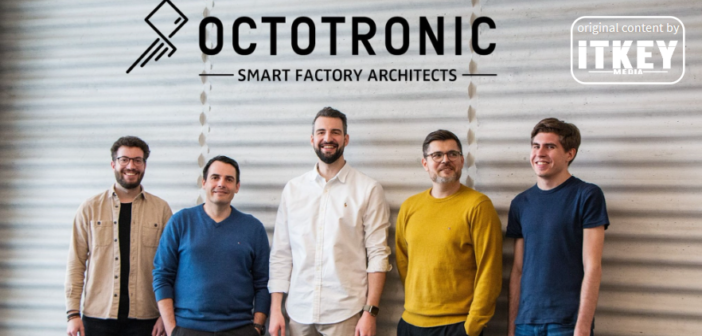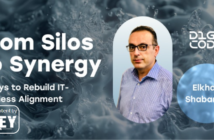- The merger between Swiss companies Octotronic and VISENSE aims to unify data in smart manufacturing through their Unified Namespace platform Octocore
- Octocore integrates sensor data, ERP, MES systems, and video analytics for process optimization
- The collaboration seeks to eliminate data silos and enhance IT-OT convergence in factories
Last December, Octotronic – the Swiss developer of smart factory data architectures and digital transformation projects – announced its merger with VISENSE, the provider of AI-driven video analytics and low-code technology, a portfolio company of the well-known Czech AI-focused VC fund Look AI Ventures. The new company’s name is Octotronic AG.
The Background of the Parties
Formed only in 2024, the Octotronic team dubs itself Smart Factory Architects, merging industrial expertise with cutting-edge AI and software innovation to shape the future of manufacturing. The startup aims to provide small factories with unified data architecture and low-code analytics toolset, empowering clients to unlock, transform, and structure data based on the unified namespace (UNS), scaling from simple dashboards to advanced AI applications.
Started in 2020, VISENSE is the Swiss startup that offers a smart error diagnosis solution for industrial machines, providing real-time visual insights into machine errors. Its system utilizes industrial cameras and selected sensors to capture machine error-related data. It then analyzes this data using machine learning and computer vision to deliver error analysis through a digital dashboard. In 2022, Look AI Ventures participated in VISENSE’s Pre-Seed round of CHF 750K.
Why Merge
The purpose of the merger is to develop OctoCore, Octotronic’s Unified Namespace (UNS) platform designed to unify and govern data across all levels of the automation pyramid. The new product eliminates data silos, facilitates IT-OT convergence, and establishes a cohesive technological ecosystem that enhances collaboration and drives scalable, cost-efficient digital transformation of small factories.
VISENSE provides a Powerful and Scalable Platform foundational platform upon which Octocore is further developed, ensuring scalability and reliability. The company also brings extensive know-how in video analytics and low-code AI platforms. This enables the processing of complex video data in real-time and the application of machine learning algorithms, all while making these technologies accessible to non-programmers.

Angelo Burgarello, Partner at Look AI Ventures
VISENSE’s expertise represents a pivotal component of OctoCore, which integrates not only sensor data and planning data from ERP and MES systems but also video data into manufacturing processes. By leveraging these data sources, OctoCore empowers smart factories, enabling advanced automation, enhanced decision-making, and seamless process optimization.
‘By combining VISENSE’s AI and industrial software expertise with Octotronic’s proficiency in smart factories, data architectures, and IoT, the combined team has already prototyped OctoCore. This collaborative product is a core AI solutions enabler on the shop floor, supporting scalable digital transformation in line with the latest Industry 5.0 trends. Moreover, the two companies’ combined list of clients includes many of the main industry players in the manufacturing landscape,’ Look AI Ventures partner Angelo Burgarello.
The Challenges of Digital Transformation in Industry
According to McKinsey, 85% of industrial companies prioritize digital transformation as global investments in digital transformation of industry reach USD 300B+ annually. Despite these investments, many projects fail, leaving manufacturers with costly yet incomplete transformations as significant technological and organizational hurdles impede progress. For instance, a recent MIT and Microsoft report indicates that while 64% of manufacturing executives experiment with AI, only 35% successfully implement AI use cases, stating inadequate data quality, weak data integration, and weak governance as common obstacles.
Octotronic’s co-founder and CEO Alexej Ziegler lists several factors causing the gap between experimenting with and successfully implementing AI use cases is caused by several factors:
- Isolated Use Case Approach: Many companies adopt a siloed strategy that solves specific digitalization problems or ideas but creates new data silos. These approaches are not scalable and often result in excessive costs.
- Lack of a Solid Data Foundation: Without a centralized data foundation and a Single Point of Truth, knowledge within the organization remains fragmented. This leads to redundant data and a lack of transparency, hindering the execution of AI use cases.
- Data Quality and Accessibility: Fragmented, unstructured, or outdated data slows progress.
- Lack of IT/OT Convergence: Operational technology (OT) and information technology (IT) often operate in silos, making efficient data integration challenging.
- Lack of Expertise: Implementing AI requires both technical expertise and a deep understanding of processes.
This, in turn, gives rise to several key challenges that the manufacturing industry inevitably faces when attempting to scale digital transformation initiatives, especially in deploying AI use cases on the shop floor:
- Heterogeneous Systems: Different protocols, machine standards, and technologies create integration difficulties.
- Hierarchical Data Silos: Data is often stored in layered silos with inconsistent or unaligned data standards. This lack of standardization hinders collaboration and scalability.
- Distributed Data Understanding: Data knowledge is scattered across departments and individual experts, often undocumented or lacking the necessary context. As a result, such data becomes unusable for meaningful insights or decision-making.
- Unstructured Data Models: Data is not organized to reflect real processes and workflows, failing to capture the physical correlations crucial for AI applications on the shop floor. This limits the ability to derive actionable insights and hampers AI’s potential impact.
- Process Understanding and AI Expertise: While AI applications hold tremendous potential on the shop floor, they require a unique combination of deep process knowledge and AI expertise. The critical link between these two domains is structured data, which is often either missing or the most resource-intensive aspect to create.

Alexej Ziegler, Co-Founder and CEO at Octotronic
According to Mr Ziegler, Octocore addresses these challenges by providing a Unified Namespace (UNS) that harmonizes data across systems, aligns it with real-world processes, and creates a solid foundation for scalable AI use cases. Its structured approach ensures that data reflects physical workflows, enabling meaningful AI-driven insights while minimizing integration complexity.
As a concrete example, the CEO boasts about such customer projects like those with VAT Group, where Octocore’s Unified Namespace (UNS) eliminated data silos and created a solid data foundation. This enabled the implementation of predictive maintenance, reducing downtime and optimizing production planning.
‘Similar approaches were applied at BMW and Mettler Toledo, where data integration and real-time insights powered by Octocore helped automate production processes and established a scalable foundation for AI-driven use cases,’ Mr Ziegler adds.
How It Works
Octocore offers seamless connectivity by providing pre-built connectors for common industrial equipment and protocols like OPC UA, MQTT, as well as enterprise systems such as ERP, MES, and SCADA, ensuring smooth data flow across the automation pyramid. The platform also includes data transformation capabilities, allowing users to convert raw data into standardized formats for meaningful storage within the Unified Namespace (UNS). The UNS interface is user-friendly, providing a transparent view of data structuring and governance, and serves as a real-time digital twin of the factory, streaming up-to-date data on operations and processes, including vision data. To ensure data quality and governance, Octocore implements measures like lineage tracking, audit trails, and role-based access control (RBAC), which are crucial for scaling AI and analytics initiatives.
Additionally, Octocore features a low-code analytics platform that supports everything from simple logic operations to advanced AI models, enabling rapid development of use cases for time series, sensor, and vision data analysis. Its dashboard builder allows users to create custom visualizations of UNS data, linking these dashboards to analytics events for real-time insights and alerts.
Recognizing the complexity of manufacturing environments, Octocore’s open architecture allows third-party applications with all mapped process structures and correlations, including visualization and analytics tools, to access and utilize unified data, eliminating integration costs and barriers. This includes integration with specialized planning tools, analytics platforms, and other custom applications. Additionally, developers are welcome to build plugins or integrate custom solutions to extend Octocore’s functionality, further tailoring it to specific customer needs.
The combination of open access, continuous connector expansion, and flexibility for third-party integrations makes OctoCore a robust platform for building an ecosystem that supports specialized use cases and drives innovation.
For shop floor connectivity, Octoсore can additionally leverage edge devices provided by Octotronic or integrate with existing edge devices at the customer’s facility. For instance, in the field of video analytics, Octotronic employs VISENSE’s solution to offer high-performance edge devices specifically tailored to handle the processing demands of video data in real time.
Overall, Octotronic assures that the deployment of Octocore is fast, straightforward, and cost-effective, ensuring minimal disruption to operations while maximizing value from the outset.
The Philosophy behind Octocore
Philosophically, Octocore is designed to align with Industry 5.0 principles by focusing on human-centricity, sustainability, and collaboration between humans and machines. It achieves this by:
- Unified Namespace (UNS) as a Foundation: OctoCore’s UNS consolidates and structures data from various sources into a centralized and standardized framework. This enables seamless access to relevant information across systems, supporting human decision-making and enhancing operational transparency.
- Sustainability: By optimizing data flows and process structures, OctoCore reduces inefficiencies, minimizes waste, and enhances resource utilization, contributing to more sustainable manufacturing practices.
- Support for Autonomous Systems: In the future, autonomous systems on the shop floor will require structured, real-time data to navigate, perform tasks efficiently, and interact with their environment. Octoсore’s UNS provides the foundational data architecture needed to enable these systems, ensuring they can work effectively and collaboratively within the production ecosystem.
By leveraging its UNS to provide structured, accessible, and actionable data, Octoсore empowers manufacturers to embrace Industry 5.0, fostering innovation, sustainability, and seamless integration between humans and machines.
‘Our vision is to revolutionize data integration in manufacturing by becoming the global standard for unified data architectures. This will enable seamless data flow and integration across all systems and platforms, eliminating data silos and enhancing collaboration. By providing a single source of truth for all stakeholders, we empower organizations to make more informed decisions, leading to transformative growth and innovation in the industry,’ Octotronic’c COO and CFO Christian Reich summarizes.
What’s Next

Christian Reich, Co-Founder, COO and CFO at Octotronic
As such, the merger marks the beginning of an exciting new chapter for both companies. Mr Reich firmly believes that, by uniting their strengths, the two companies are poised to accelerate growth, expand the new company’s market presence, and deliver even greater value to clients.
With joined forces, the companies are planning to scale our operations and are exploring opportunities for additional funding with strategic investors to support our ambitious innovation and expansion goals. Mr Ziegler shares that Octotronic aims to leverage additional funding to accelerate innovation, expand its market presence, and enhance OctoCore further. The prospective investments will drive the development of advanced features like AI integration, real-time analytics, and enhanced support for third-party ecosystems, ensuring Octocore remains the go-to platform for data integration and smart manufacturing.
‘We also plan to scale globally, targeting key markets and industries with growing demand for seamless digital transformation solutions. Strategic funding will support ecosystem partnerships, talent acquisition, and R&D, enabling us to build a robust platform that addresses real customer challenges while fostering collaboration with third-party solutions. For investors, this represents an opportunity to be part of a transformative growth story, as Octotronic redefines the future of manufacturing with scalable, interoperable, and high-value solutions,’ Mr Ziegler tells ITKeyMedia.
In the meantime, Octoctronic’s Octocore ensures that small factories’ data is structured, accessible, and standardized, generating value faster without wasting resources on complex integrations or deciphering data. This approach not only simplifies adoption but also creates opportunities for collaboration with a wide range of solutions, fostering a dynamic and innovative ecosystem.

Kostiantyn is a freelance writer from Crimea but based in Lviv. He loves writing about IT and high tech because those topics are always upbeat and he’s an inherent optimist!





